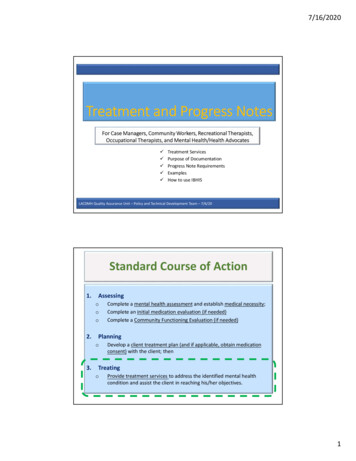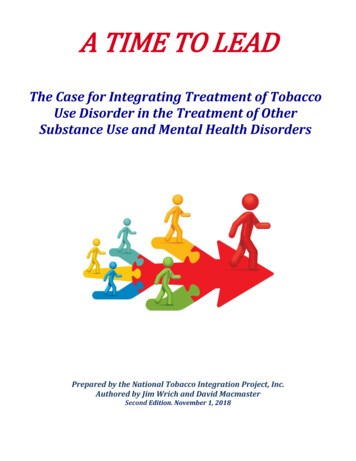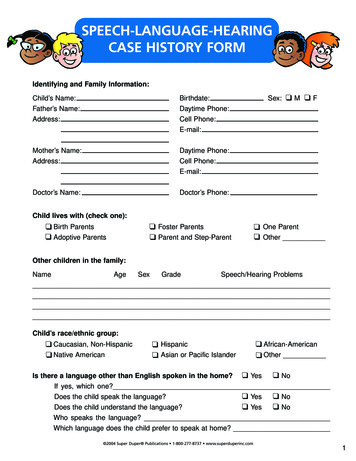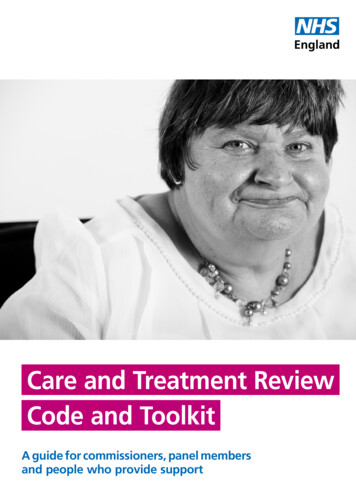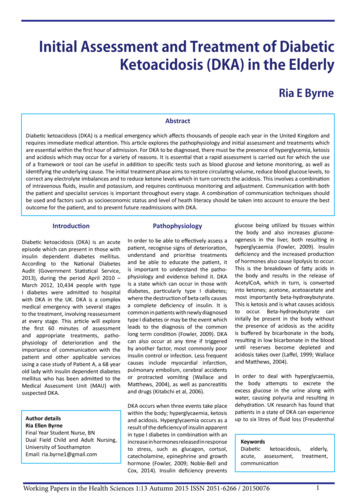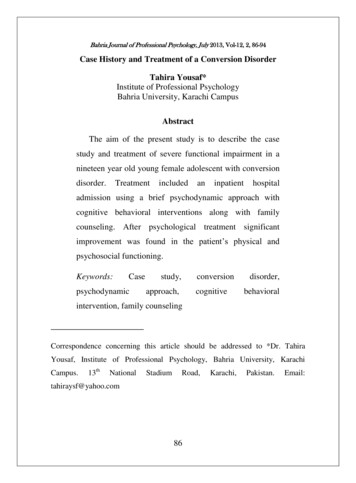
Transcription
Bahria Journal of Professional Psychology, July 2013, Vol-12, 2, 86-94Case History and Treatment of a Conversion DisorderTahira Yousaf*Institute of Professional PsychologyBahria University, Karachi CampusAbstractThe aim of the present study is to describe the casestudy and treatment of severe functional impairment in anineteen year old young female adolescent with pitaladmission using a brief psychodynamic approach withcognitive behavioral interventions along with familycounseling. After psychological treatment significantimprovement was found in the patient‟s physical andpsychosocial ion, family counselingCorrespondence concerning this article should be addressed to *Dr. TahiraYousaf, Institute of Professional Psychology, Bahria University, hoo.com86Karachi,Pakistan.Email:
YousafConversion disorder is basically a psychological disturbance with physicalmanifestations. In DSM IV TR, (2000) conversion disorder is defined asthe presence of neurological signs, without any organic disturbances, inwhich the person suffers from deficits of sensory or motor activity. Afterthe complete medicalexamination, which includes a thoroughneurological examination and different laboratory and radiographicdiagnostic tests, there are no neurological deficits present for thesymptoms. Furthermore, symptoms of an organic medical disorder ordisturbance in normal neurological functioning present those are notreferable to any medical or neurological cause (Roelofs, Van Gallen,Keÿers, Hoogduim, 2002). Sigmund Freud identified these signs ashysteria which is basically a defense mechanism use a person in order toovercome his/her severe life stressors (Freud, 1962). Conversionsymptoms can be considered as unconscious and cannot be explain asphysical disorder.The best explanation of conversion disorder was drawn from thepsychoanalytical approach. Freud used the term conversion for the firsttime for repressed needs (Freud, 1962). He used catharsis as a therapeutictechnique through which unconsciously subdued needs might becomeconscious. Freud used hypnosis and free association to uncover the intrapsychic conflicts. These conflicts are basically the needs of sexuality,aggression, or dependency against their expression (Kaplan, Sadock,Baltimore, Williams & Wilkins, 1995). In conversion disorder theseunconscious needs manifest in the form of symbolic presentation.87
Case History and Treatment of a Conversion DisorderThe learning theory also explained the etiology of conversiondisorder as the patient‟s belief to get the external benefits associated withassumption of the sick role. The basic aim of all behavioral approaches isto modify the relationship between behaviors and their consequences in away that it becomes one of the greater benefit to the patient to give up thesymptoms than to preserve them (Munford, 1978). Cognitive–behavioraltherapy is also an effective treatment for unexplained medical illness andneurological symptoms (Barsky & Ahern, 2004). Family counseling isalso beneficial for the treatment of conversion disorder especially wherethe dynamics associated with family issues (Moene, Landberg, & Hoogduin,2000).The treatment outcome of conversion disorder have been reportedin different case studies (Lock & Giammona, 1999). Successful treatmentof conversion disorder was found in improving children‟s functioningthrough rehabilitation, behavioral techniques with combination ofrelaxation techniques and family therapy (Brazier & Vennin, 1977; Campo& Negrini, 2000; Lock & Giammona, 1999).Cognitive behavior therapy, psychodynamic approach and familytherapy found to be affective in the treatment of conversion disorder butsuccessful rate was not defined (Whiting, Bagnall, Snowden, 2001)whereas hypnosis seems as not supportive in its treatment (Singh & Lee1997).88
YousafCase HistoryNazia (not her real name), was nineteen years old girl who wasbrought to the local hospital in psychiatric ward in mute condition whereshe was admitted immediately for treatment.A night before her mute condition she was busy in the householdchores till late at night. The next morning she developed the mutecondition and for three days she did not talk nor did she have any food.When she was brought to the psychiatric ward, the doctors suggested ECTbecause the client had the same problem since last three years and almostafter every fourth or fifth month she became mute and only after receivingECT she could open her mouth to talk and eat.Nazia was the eldest in the family and had three step sisters andthree step brothers. Her real mother was died when she was just two yearsold. Her father got married again. She has the responsibility of all thehousehold chores. Nazia wanted to study after class 5 but her mother didnot allowed her.She was in love with her cousin but her step mother did not like it.She used to meet her cousin at her aunt‟s place. When her mother came toknow about her meetings with her cousin she had a severe fight with her.That was the day when had her first attack. She became unconscious andafter that she became mute and could not open her mouth.89
Case History and Treatment of a Conversion DisorderMs. Nazia was admitted in a psychiatric ward and she was shownto several different doctors, neurologist and examined for all possiblecause of her severe condition. She was stayed in this condition for threedays and was being given nasal feeding.The Psychiatrist diagnosed herwith a conversion disorder and ECT was the possible treatment for hercondition. The Psychiatrist at this time asked the psychologist to come andsee the patient. The Psychologist visited Nazia and called her father.Her father gave the entire history and after that her step motherwas called by the psychologist separately, who gave her view of the wholething. The step mother seemed to be over powered and authoritativewoman and father as submissive. Her father was not happy with herposition in the house and he also wished for her wedding. However herstep mother did not want her wedding as Nazia had the responsibilities ofthe entire household.TreatmentTherapeutic TechniquesPlacebo effectPsychologist visited Nazia after all the physical diseases had been ruledout. The psychologist spoke to Nazia saying that “I am a doctor and knowyour problem in its real sense that is occuring due to your step mother. Ihave already talked to her for your marriage and she has agreed with it. I90
Yousafknow for sure that this is your main problem and this problem has beensolved, now open your mouth and talk to me”.The same instructions were repeated for five times and then thepsychologist gave a glass of “holy” water as a chemical agent (placebo) toNazia telling her to drink it and then she would be able to talk to thepsychologist. After taking two sips of water Nazia slowly began to talkwith the psychologist. Nazia informed that she wanted to get married toher cousin. She started talking without any ECT or medication for the firsttime. Nazia was discharged from the hospital but kept coming forpsychotherapy along with her father and step mother for another threemonths.Free AssociationIn initial sessions the psychologist explored the intra-psychicconflicts of Nazia through free association. It was found that theseconflicts are usually derived from the needs of sexuality, aggression andinternalized prohibitions against their expression. The psychologist alsoworked on the unacceptable impulses of Nazia out of conscious awarenesswhile getting its expression in symbolic form.Cognitive RestructuringIn further sessions the psychologist focused on cognitive behaviorinterventions and identified the negative cognitions of the client whichlead her towards maladaptive behavior. The psychologist used cognitive91
Case History and Treatment of a Conversion Disorderrestructuring in order to make the client‟s cognitions positive and actaccordingly.Family CounselingAlong with the aforementioned issues, family counseling was alsofocused upon. In this possible reasons of Nazia‟s problem waere discussedwith her father. The father was cooperative and accepted theresponsibilities. Initially the father was suggested to motivate the client‟sstep mother for counseling as she was reluctant but after few sessions shealso accepted and tried to understand Nazia‟s needs.Follow upDuring the follow up of three years she is now married to hercousin and has a happy married life and has been blessed with a baby boy.ConclusionIt is concluded that psychotherapy using a placebo as well asfamily counseling is effective in this case without other medicalprocedures like ECT and psychotropic drugs. Furthermore, it can be saidthat psychotherapy and family counseling is a helpful therapeutic choicefor conversion disorders especially in adolescence. Therefore, conversionsymptoms represent a common pathway for the expression of complexbiopsychosocial events. The case of Nazia demonstrates the importance ofpsychoanalysis, cognitive behavior therapy and the role of familycounseling.92
YousafReferencesBarsky, A. J., & Ahern, D. K. (2004) Cognitive behavior therapy forhypochondriasis: Arandomized controlled trial. Journal ofAmerican Medical Association, 291, 1464–1470.Brazier, D. K., & Venning, H. E. (1997). Conversion disorders inadolescents: A practicalapproach to rehabilitation. BritishJournal of Rheumatology, 36, 594-598.Campo, J. V., & Negrini, B. J. (2000). Case study: Negative reinforcementand behavioral management of conversion disorder. Journal of theAmerican Academy of Child andAdolescent Psychiatry, 39,787 -790.DSM IV TR. (2000). Diagnostic and statistical manual of mentaldisorders (4th ed.). Washington DC, USA: American PsychiatricAssociation.Freud, S. (1962). The Neuropsychosis of defence, 3. London, UK: HogarthPress.Kaplan, H. I., Sadock, B. J., Baltimore, Williams & Wilkins. (1995).Somatoform disorders. Comprehensive Textbook of Psychiatry, 6,1252-1258.Lock, J. & Giammona, A. (1999). Severe somatoform disorder inadolescence: A case seriesusing a rehabilitation model for93
Case History and Treatment of a Conversion Disorderintervention. Clinical Child Psychology and Psychiatry,4, 341-351.Moene, F. C., Landberg, E. H., & Hoogduin, K. A. (2000). Organicsyndromes diagnosed as conversion disorder: Identification andfrequency in a study of 85patients. Journal of PsychosomaticResearch, 49, 7-12.Munford, P. R. (1978). Conversion disorder. Psychiatry Clin NorthAmerica, 1, 377-390.Roelofs, K., Van Gallen, G., Keÿers, G., Hoogduim, C. (2002). Motorinitiation and execution in patients with conversion paralysis.Acta Psychology, 110, 21-34.Singh, S. P., Lee, A. S. (1997). Conversion disorders in Nottingham:Alive, but not kicking. Journal of Psychosomatic Research, 43,425–30.Whiting, P., Bagnall, A. M., Snowden, A. J. (2001). Intervention for thetreatment and management of chronic fatigue syndrome: asystematic review. Journal of AmericanMedical Association,286, 1360–8.94
psychic conflicts. These conflicts are basically the needs of sexuality, aggression, or dependency against their expression (Kaplan, Sadock, Baltimore, Williams & Wilkins, 1995). In conversion disorder these unconscious needs manifest in the form of symbolic presentation.
